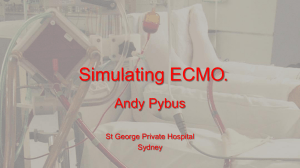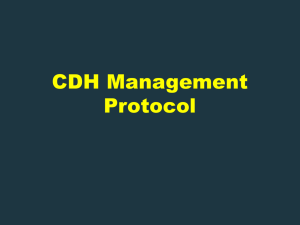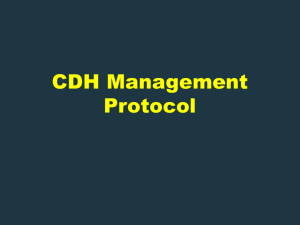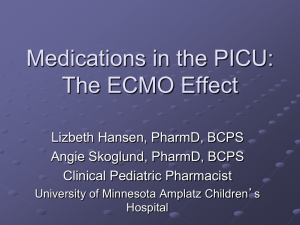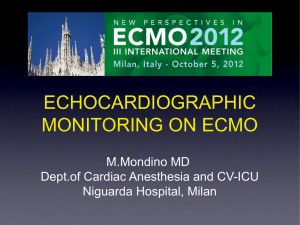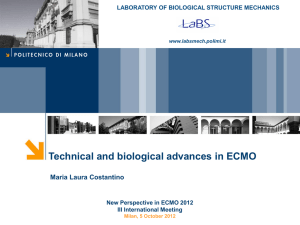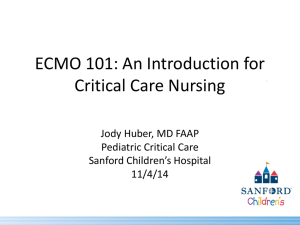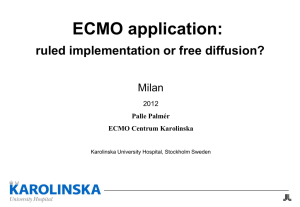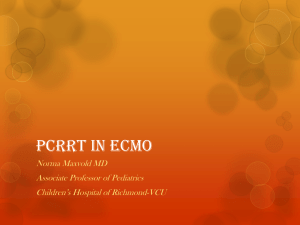Fellow`s Conference: Medical management of Neonatal ECMO
advertisement
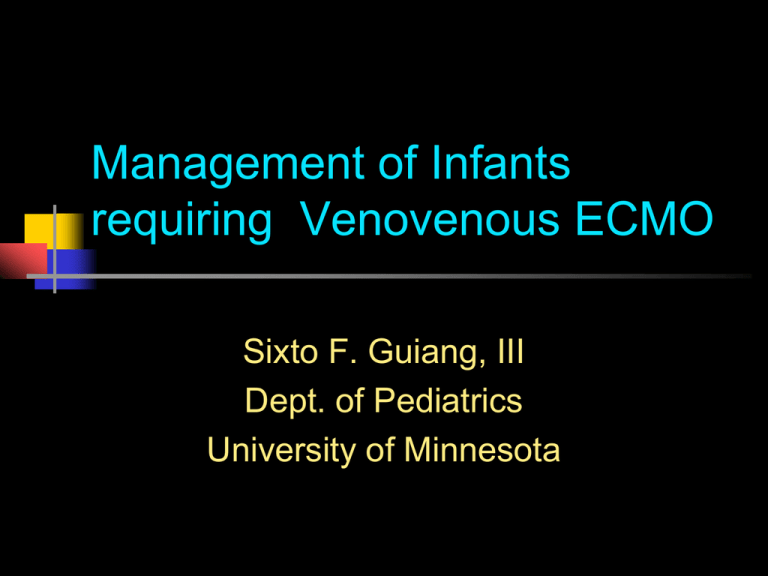
Management of Infants requiring Venovenous ECMO Sixto F. Guiang, III Dept. of Pediatrics University of Minnesota Neonatal ECMO = 73 % of all ECMO VV ECMO = 20% of all Neonatal Pulmonary University of Michigan JAMA 2000;283:904-908 N= 1000 Newborns N=586 Survival MAS CDH Others 90% veno-venous 9% IVH 88% 98% 68% 84-93% VV ECMO Respiratory Mode for all ages Infants 20% of all Respiratory ECMO Approximately 800 cases / yr Pediatric 28% of all Respiratory ECMO Approximately 200 cases / yr Pediatric VV ECMO Pediatr Crit Care Med 2003;4:291-298 Single Center 1991-2002 N = 82 ECMO for Respiratory Failure Venovenous Venoarterial Unable to place VV 83% 17% 43% Pediatric VV ECMO Venovenous Dx ARDS RSV bronchiolitis Penumonia Outcomes Lower degree of respiratory failure Shorter ECMO (212 hour vs 350 hours) Higher survival (81% vs. 64%) Pediatric VV ECMO Pediatr Crit Care Med 2003;4:291-298 Infusion limb Drainage limb Inclusion / Exclusion Guidelines- Same as VA age of at least 34 weeks Weight >1.5-2.0 kg Potentially reversible process Absence of uncorrectable cardiac defect Absence of major intracranial hemorrhage Absence of uncorrectable coagulopathy Absence of lethal anomaly Absence of prolonged mechanical ventilation with high ventilatory settings Oxygenation Failure Criteria - VA and VV Alveolar - arterial oxygen tension gradient [760 - 47)-paCO2] - paO2 605 - 620 torr for greater than 4-12 hours Oxygenation index Mean Airway Pressure x FiO2 x 100/ paO2 > 35-60 for greater than 1-6 hours Oxygenation Failure Criteria - VA and VV paO2 PaO2 < 35 for 2 hours paO2 < 50 for 12 hours Acute decompensation paO2 < 30 torr Myocardial Failure - VA Only Refractory hypotension Low cardiac output pH <7.25 for 2 hours or greater Uncontrolled metabolic acidosis secondary to hemodynamic insufficiency Cardiac arrest - CPR Additional Exclusion Criteria Venovenous ECMO Severe LV dysfunction Severe hypotension Cannulation during CPR Desire to not have heparin Bleeding Additional Exclusion Criteria Venovenous ECMO Use of vasopressors is NOT a contraindication for VV ECMO Isolated RV failure is NOT a contraindication for VV ECMO Vasopresor - VV ECMO ASAIO Journal 2003;49:568-571 Neonatal ECMO-VA and VV N = 43 Quantified inotropic support - Index 1 point = 1mcg/kgmin Dopamine Dobutamine 1 point = 0.01 mcg/kg/mon Epinephrine Norepinephrine ASAIO Journal 2003;49:568-571 ASAIO Journal 2003;49:568-571 ASAIO Journal 2003;49:568-571 Infants with Inotropic Score > 10 ASAIO Journal 2003;49:568-571 ECMO Goals - VA and VV Maintain adequate tissue oxygenation to allow recovery from short term cardiopulmonary failure Adjust ventilator settings allowing for Lung Rest minimizing further ventilator /oxygen induced lung injury. Not necessarily lower settings ECMO Modes Venoarterial - VA Blood drains-venous system Blood returns-arterial system Complete cardiopulmonary support Venovenous - VV Blood drains-venous system Blood returns-venous system Pulmonary support only Advantages of VA ECMO Able to give full cardiopulmonary support No mixing of arterial / venous blood Good oxygenation at low ECMO flows Allows for total lung rest Disadvantages of VA ECMO Ligation of the right carotid artery Nonpulsatile arterial blood flow Suboptimal conditions for LV function Low preload High afterload High wall stress Low coronary oxygenation Disadvantages of VA ECMO Systemic emboli Air thrombus Advantages of VV ECMO No ligation of carotid artery Normal pulsatile blood flow Optimize LV performance More preload Less afterload Better coronary oxygenation Less ventricular wall stress No systemic emboli Disadvantages of VV ECMO Need a functioning LV Mixing of blood lower arterial saturation Need increased ECMO flow Need higher hemoglobin Need to place a larger cannula More difficulty monitoring adequacy of oxygen delivery Recirculation of ECMO flow Disadvantages of VV ECMO May need to convert to VA Need to be fully heparinized Cannula cannot be heparin bonded VV ECMO -Double lumen Newborns >90% of VV ECMO - Double lumen 12F and 15F OriGen Pediatric 35% of VV ECMO -double lumen 18F - largest OriGen cannula 65% internal jugular, femoral, sapphenous VV ECMO -Double lumen Cannula site Internal jugular vein (15F double lumenpreferred) Cannula tip low in the right atrium Drainage Infusion High lateral RA Mid Medial RA Low lateral RA Endhole Optimal Cannula Placement Adequate size Correct depth Correct Rotation Low Right Atrium Label visible Drainage limb (Blue) posterior Infusion limb (Red) anterior Vertical orientation Head - midline No Kinks Recirculation Oxygenated ECMO blood returning to the ECMO circuit immediately after infusion Recirculation factors Head /cannula position Changes with head rotation Changes in lung volume / relative position of the heart and cannula ECMO flow Right atrial size / intravascular volume RV contractility ECMO blood flow to baby - 160 ECMO Flow reads 200 ECMO blood flow to baby - 250 ECMO Flow reads 500 ECMO Flow -Recirculation More ECMO flow will always increase recirculation More ECMO flow may either Increase blood flow to baby Decrease blood flow to baby VA ECMO ECMO flow rate is proportional to the level of support More flow More support Always advantageous if more flow is possible More ECMO flow will always increase SvO2 Pulmonary Support - VV Net ECMO blood flow of infant = measure ECMO flow - recirculation flow ECMO flow (flow probe) DOES NOT indicate level of support SvO2 DOES NOT reflect level of systemic oxygen delivery Circulatory Support Net flow to baby assessed by Infant color Infant arterial saturation and PaO2 Assessment of Recirculation More recirculation if Decreasing baby arterial sat or PaO2 Increasing SvO2 on ECMO circuit Decreasing color difference on drainage and infusion limbs of circuit Reducing Recirculation Adjusting relative cannula position Head position Lung inflation Decrease ECMO flow Increase intravascular volume Increase RV contractility Volume Vasopressors Pulmonary vasodilators VV - VA Conversion Needed if 10-15% of cases Hemodynamic support is inadequate Respiratory support is inadequate More problematic when ultrafiltration is used VV ECMO - Specific Issues ECMO Prime Must have added heparin Must have Ca added Ionized Ca on circuit must be checked prior to cannulation Potassium must be checked Heparin If no heparin added Addition of Ca binds citrate of blood products Loss of anticoagulant activity Acute clotting of the entire circuit Need to prime another circuit Calcium If no calcium added Acute hypocalcemia - Ca binds to citrate of blood products Loss of LV and RV contractility Acute hypotension Cardiac arrest Potasium If potassium in prime is not checked Possible higher serum K from the stored PRBC Acute hyperkalemia Arrythmia Cardiac arrest Head / Cannula Position Distal tip low in RA Head in the midline with vertical orientation of the drainage and infusion limbs RA drainage ports Lateral Infusion ports Medial Keys to Management VV ECMO- DL Need to think in terms of NET blood flow to the baby Cannot quantify NET flow SvO2 is not indicative of adequacy of systemic oxygen delivery Indirectly assessed with SaO2 and PaO2 on the infant To Improve oxygenation Give PRBC Increase ECMO flow Decrease recirculation Check cannula position Increase ntravascular volume Increase RV contractility Rest Ventilator Settings Pressures - similar to VA FiO2 - able to wean to RA frequently Better myocardial oxygenation via ECMO flow than VA Jugular venous drainage 11% of all double lumen VV Small study suggested decrease IVH Reduced cerebral venous pressure Advantage Additional drainage facilities flow 2 site venous drainage lessens recirculation on VV ECMO Improved oxygen delivery Enables venous oxygen saturation monitoring on VV ECMO Jugular Venous Drainage Cephalad Cannula J Pediatr Surg 2004;39:672-676 Review of ELSO database Neonatal Respiratory Failure VV ECMO 1989-2001 N = 2471 96% VV double lumem alone 3.7% with jugular venous drainage Similar Outcomes Operating Parameters SaO2 - 85-95% PaO2 40-65 torr Blood pressure - similar to VA ECMO flows - 130-150+ ml/kg/min HgB 12-15 g/dl Weaning of ECMO - VV No clamp out needed Increase ventilator Decrease sweep gas flow rate and FiO2 Sweep gas flow can be completely stopped SvO2 will reflect mixed venous saturation No recirculation Gas Flow NO Gas Flow VV ECMO Outcomes Generally slightly better than VA, but slightly different patient populations Hemodynamically more stable Less exposure to CPR Better survival Shorter duration of ECMO Conversion VV to VA 12% VA - VV Comparison studies J Peds Surg1993;28:530-536 Multicenter data N=243 VA = 135 VV = 108 Similar survival 10% conversion to VA Shorter runs Less Neurologic complications

